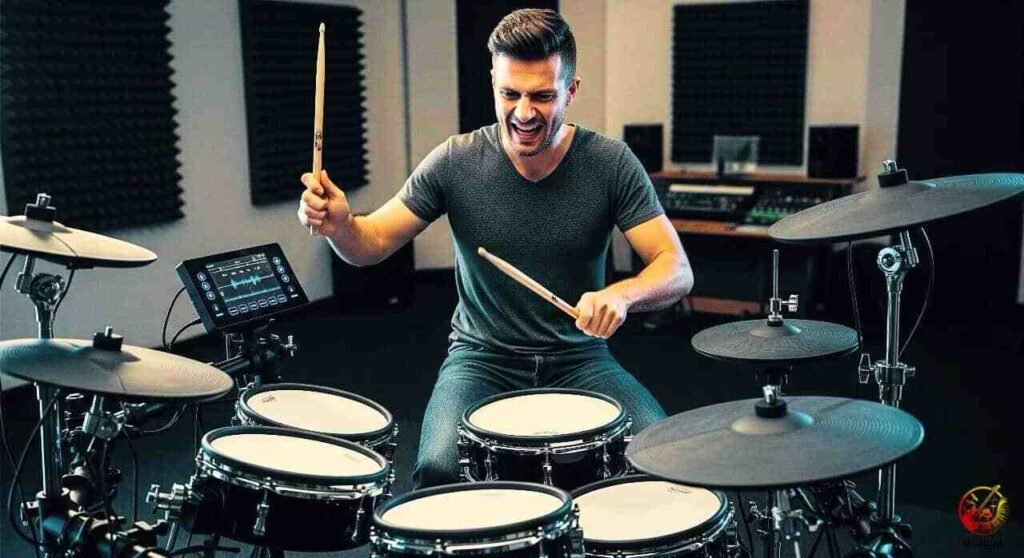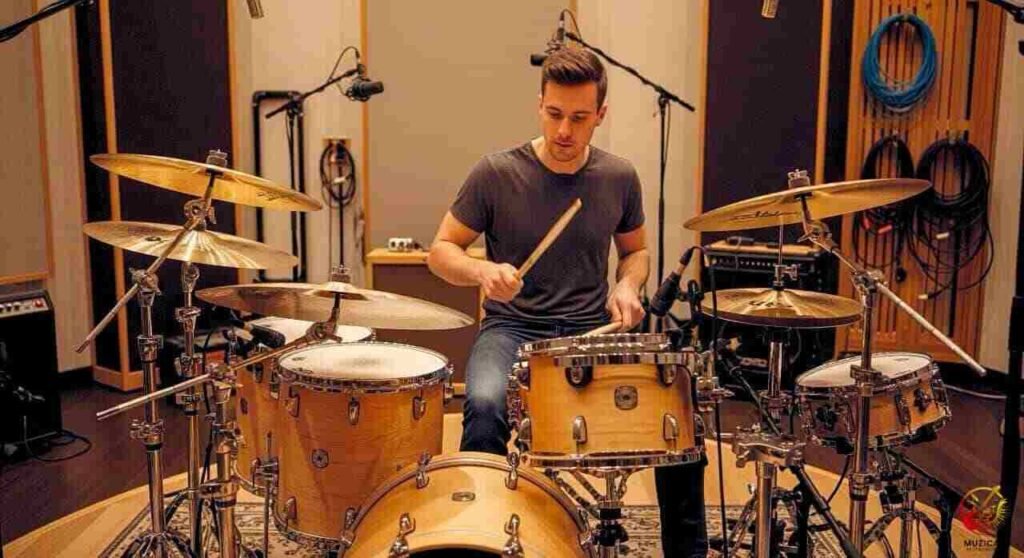Transitioning from Electronic Drum to Acoustic Kit: What’s Really Different?
Transitioning from electronic drum to acoustic kit is a big step many drummers take after mastering their e kits. About 60% of electronic drummers eventually make this switch, wanting the real feel and sound that only wood and metal can give.
This switch isn’t just about buying new gear. It’s about learning new ways to play, understanding how real drums work, and dealing with louder volumes.
We’ll talk about the main differences between electronic and acoustic drums, the steps to make the change, problems you might face, and how to set up your first real drum kit.
Why Do Electronic Drummers Switch to Acoustic Kits?

Many drummers start transitioning from electronic drum to acoustic kit because e-kits can’t match the real thing. Electronic drums work great for practice at home, but they miss the complex sounds that real drums make. Even expensive electronic drums struggle to copy how acoustic drums respond to your touch.
When you hit a real snare drum off center, you get a totally different tone. Electronic pads can’t do this fully, no matter how good the module is. This is what makes acoustic drums feel alive when you play them. The mesh pads on e-kits try to copy this feel, but it’s not the same.
Real drums also push air when you hit them. You feel this through your whole body, not just your hands. Many electronic drummers say they feel cut off from their playing, like there’s a wall between them and the music.
Live gigs present another reason for switching. While e kits work fine in studios, they often sound weak in live venues where acoustic instruments rule the mix. The natural punch of acoustic drums cuts through a band mix better than amplified electronic sounds.
What’s Different About Playing Acoustic vs Electronic Drums?

The feel between e kits and acoustic drums is totally different. These changes will require you to adjust your drumming technique in several ways.
Stick bounce works completely different on real drums. Electronic pads give steady bounce no matter how you hit them. Real drum heads respond to your stick angle, speed, and where you hit with different amounts of rebound. This means your ghost notes, rim shots, and cross-stick work will all feel strange at first.
The volume range is probably the biggest shock. E kits compress your playing to fit digital limits, but acoustic drums respond to everything you give them. Your softest touch makes real whispers, while your hardest hits can fill a room. This bigger range means you need to learn new ways to control volume and dynamics.
| Playing Part | Electronic Drums | Acoustic Drums |
|---|---|---|
| Stick Bounce | Same every time | Changes with technique |
| Volume Control | Amp settings | Your muscles |
| Sound Changes | Limited samples | Endless with technique |
| Feel | Little vibration | Full body response |
Cymbals are another big change. Electronic cymbal pads stop moving right after you hit them, but real cymbals keep ringing and affect each other. You need to learn how to stop cymbals from ringing too long and understand how your cymbal choices change your whole sound.
How Should You Prepare Your Technique for Real Drums?

Getting your drumming technique ready for acoustic drums needs work in several key areas. Your e kit experience gives you a good start, but you need to polish certain parts of your playing.
Stick control becomes much more important with acoustic drums. Electronic drums forgive sloppy technique because samples trigger the same way no matter how you hit the pad. Real drums punish poor technique with uneven sounds, unwanted buzz, and bad tones. Start practicing with a click track on a practice pad. Focus on keeping your sticks at the same height and hitting clean, straight down.
Volume control needs a complete reset of how you play. Electronic drummers often play at medium strength because volume comes from the amp, not how hard you hit. With real drums, every volume level needs exact muscle control. Practice playing simple beats at different volumes, making sure each hit keeps good technique.
Your arms and wrists will be tested differently on acoustic drums because the feedback changes how your body responds. The vibrations and air movement from drums affect your balance in ways e-kits don’t. Spend extra time on basic coordination work on practice pads that feel more like real drums.
Expert Tip: Pro drummers suggest spending two weeks playing only with sticks on practice pads before touching your first acoustic kit. This helps retrain your hands without trying to manage too many new things at once.
Learn to hear tuning and drum sounds before you start playing acoustic kits regularly. Electronic drummers often lack experience with tuning because their sounds come ready made. Learn to tell when drums are tuned too high, too low, or uneven.
What Gear Do You Need for Your First Acoustic Setup?
Building your first acoustic kit needs careful thought about several parts that electronic drummers might not know about buying. Unlike e-kits where everything comes together, acoustic setups involve many separate choices.
Your drum shell choice affects both sound and playability. Birch shells give bright, cutting tones perfect for rock and pop music. Maple offers warmer, more balanced sounds good for jazz. Shell depth also matters, deeper shells make lower basic tones, while shallow shells emphasize attack and stick definition.
Hardware quality directly impacts your playing comfort and how long your setup lasts. Cheap hardware will shake, slip, and break with regular use. Buy double braced stands for your snare and hi-hat. Make sure your kick drum pedal moves smoothly and feels solid.
| Part | Budget Choice | Mid-Range | Professional |
|---|---|---|---|
| Drum Set (5-piece) | $400-600 | $800-1500 | $2000-4000+ |
| Cymbal Set | $200-400 | $600-1200 | $1500-3000+ |
| Hardware Pack | $150-250 | $400-600 | $800-1200+ |
| Total Cost | $750-1250 | $1800-3300 | $4300-8200+ |
Cymbal choice deserves special attention because cymbals mostly define your sound and usually last longer than drum sets. Start basic: 14-inch hi-hats, one crash, and a ride. Focus on cymbals from known makers like Zildjian, Sabian, or Meinl. Cheap cymbals sound harsh and break easily.
Don’t forget good drum heads and tuning tools. The heads that come with budget drums are often poor quality. Plan to buy replacement heads from companies like Evans, Remo, or Aquarian. You’ll also need a drum key for tuning.
What Problems Will You Face When Switching?

Transitioning from electronic drum to acoustic kit brings several expected challenges that can frustrate even experienced electronic drummers.
Volume becomes your biggest immediate problem. Electronic drummers are used to perfect volume control through amps, but acoustic drums make volume through physical force. Your first few sessions will likely involve playing too loud. This is especially bad with snare drums and cymbals, which can be painfully loud in small spaces.
Tuning and maintenance bring completely new skills that electronic drummers never needed. Your drums will go out of tune regularly, heads will wear out and need changing, and hardware will need constant adjustment. Unlike e-kits that keep consistent sound and setup, acoustic drums demand ongoing attention.
Hand and wrist tiredness increases a lot when switching to acoustic drums. Electronic pads need less physical energy to make sound, so your muscles aren’t ready for the impact forces in acoustic playing. Expect soreness in your hands, wrists, and arms for the first few weeks. Some drummers even develop tendonitis if they don’t build up gradually.
The sound chaos of acoustic drums can overwhelm electronic drummers at first. Instead of clean, separate samples, acoustic drums make complex harmonic interactions and room sound that create a much busier sonic landscape.
Pro Tip: Start your acoustic drum sessions with shorter practice periods and slowly increase time as your body adapts. Thirty-minute sessions work better than trying to power through hour-long practices.
Equipment problems will test your patience. E-kits rarely break during use, but acoustic drums can develop buzzes, rattles, and tuning problems mid-session. Learning to quickly find and fix these issues becomes essential.
How Do You Set Up Your First Acoustic Kit Right?
Proper acoustic drum setup needs attention to comfort, sound improvement, and room considerations that electronic drummers might not have dealt with.
Drum placement should focus on comfort and easy reach over looks. Your snare drum sits at a height where your arms hang naturally with sticks level to the ground when hitting the center of the head. The bass drum should put your foot comfortably on the pedal without stretching. Toms should form a gentle curve around you, with each drum reachable without awkward arm positioning.
Cymbal positioning needs more thought than electronic cymbal pad placement because real cymbals move when hit and keep vibrating. Your hi-hats should sit slightly higher than your snare drum and close enough that you can play them without reaching. Crash cymbals should angle slightly toward you.
Room acoustics dramatically affect your acoustic drum sound in ways that don’t matter with e-kits. Hard surfaces reflect sound and create harsh, ringy tones, while soft surfaces absorb sound. Most home practice rooms benefit from a mix, carpet or rugs under the drums, but leaving some hard surfaces for sound projection.
Tuning your drums properly makes the difference between professional and amateur sound quality. Start with equal tension at all lugs, then adjust to taste. Higher tuning emphasizes attack and stick definition, while lower tuning provides more body and sustain.
Watch your practice volume and consider your acoustic environment. Acoustic drums are loud, often over 100 decibels up close. This affects both your hearing and your relationships with neighbors. Consider practice time limits, acoustic treatment, or low-volume practice solutions.
Making Your Switch: Your Action Plan
Successfully transitioning from electronic drum to acoustic kit needs a structured approach that builds skills step by step while managing the various challenges involved.
Start with borrowed or rented equipment before making major purchases. Most music stores rent drum kits, and many rehearsal facilities offer hourly room rental with acoustic kits provided. This lets you experience acoustic drums without the commitment.
Focus on basic technique development during your first month. Spend most of your practice time on basic exercises, single strokes, paradiddles, and simple grooves, played at various volume levels. This builds the physical foundation necessary for acoustic drum control.
Slowly increase your practice complexity and duration as your technique gets stable. Week one might involve 20-minute sessions focused entirely on snare drum technique. By week four, you should be comfortable playing complete songs with proper volume control.
Schedule regular maintenance and tuning sessions as part of your routine. Unlike e-kits that keep consistent performance, acoustic drums need ongoing attention to keep them sounding good. Set aside time weekly for basic tuning adjustments.
Connect with other acoustic drummers in your area for advice, practice opportunities, and support. The acoustic drumming community often shares knowledge about local drum teachers, practice spaces, and equipment deals that can speed up your transition.
Your electronic drumming experience gives valuable advantages in this transition, you already understand rhythm, coordination, and musical concepts. The challenge lies in adapting these skills to work with the physical realities of acoustic instruments. With patience and systematic practice, most electronic drummers successfully complete transitioning from electronic drum to acoustic kit within three to six months.
The journey from e-kits to acoustic drums opens new possibilities for musical expression that digital instruments simply can’t copy. While the learning curve requires dedication and patience, the reward of playing instruments that respond with infinite subtlety to your physical input makes every challenge worthwhile.
FAQ: Transitioning from Electronic Drum to Acoustic Kit
1. How long does it take to transition from electronic drums to acoustic drums?
Most drummers need 3-6 months to fully adjust to acoustic drums. The first 2-4 weeks focus on technique changes, while months 2-6 involve building muscle memory and getting comfortable with volume control and tuning.
2. What’s the biggest challenge when switching from electronic to acoustic drums?
Volume control is the biggest challenge. Electronic drummers are used to controlling volume through amps, but acoustic drums require physical force control. Your first sessions will likely be much louder than intended.
3. Do I need to relearn drumming technique when switching to acoustic drums?
You don’t need to relearn everything, but you’ll need to adjust your technique. Stick control, dynamics, and rebound response all work differently on acoustic drums. Your coordination skills transfer, but physical execution needs refinement.
4. How much should I expect to spend on my first acoustic drum kit?
Budget $750-1,250 for a complete beginner setup, $1,800-3,300 for mid-range quality, or $4,300+ for professional gear. This includes drums, cymbals, hardware, and basic accessories like drum heads and sticks.
5. Can I practice acoustic drums at home without disturbing neighbors?
Acoustic drums are loud (100+ decibels), making home practice challenging. Solutions include practice pads, mesh heads, low-volume cymbals, sound dampening materials, or renting practice space. Some drummers practice during acceptable daytime hours.
6. What’s the main difference in feel between electronic and acoustic drums?
Acoustic drums provide variable stick rebound, air movement, and body vibrations that electronic pads can’t replicate. Every hit feels different based on your technique, creating a more dynamic and responsive playing experience.
7. Should I rent or buy my first acoustic drum kit?
Rent first to test different setups and confirm you want to make the switch. Most music stores offer monthly rentals, and rehearsal studios provide hourly access. This helps you understand what features matter most before buying.
8. Will my electronic drumming skills transfer to acoustic drums?
Yes, your rhythm, coordination, and musical knowledge transfer completely. However, the physical execution, volume control, and maintenance skills are new. Think of it as adapting existing skills to a new instrument rather than starting over.
